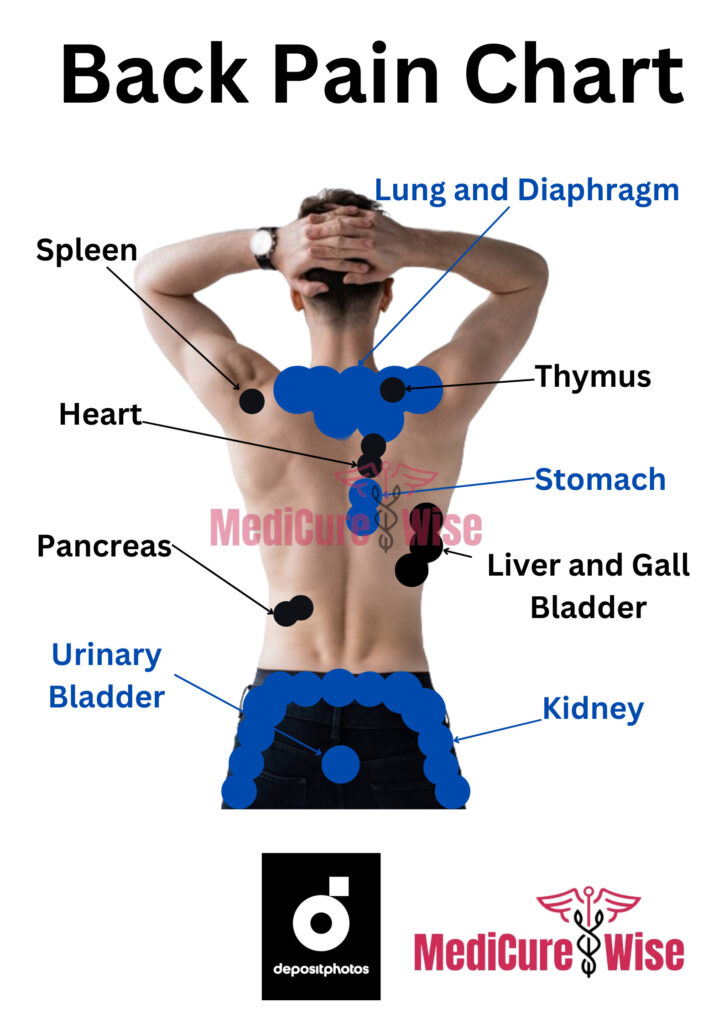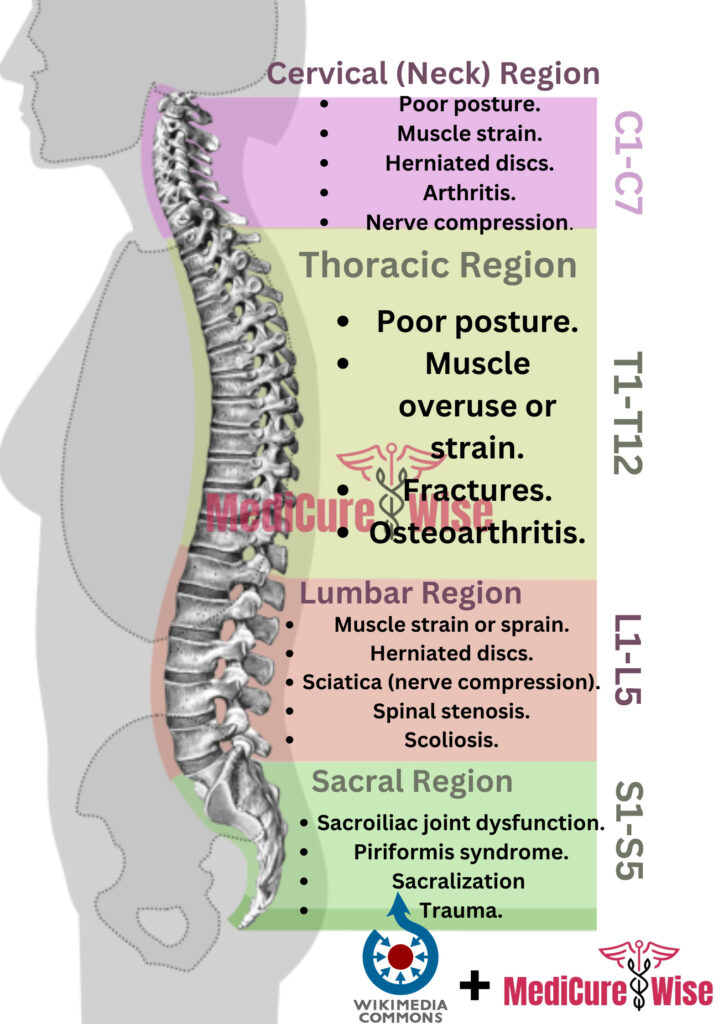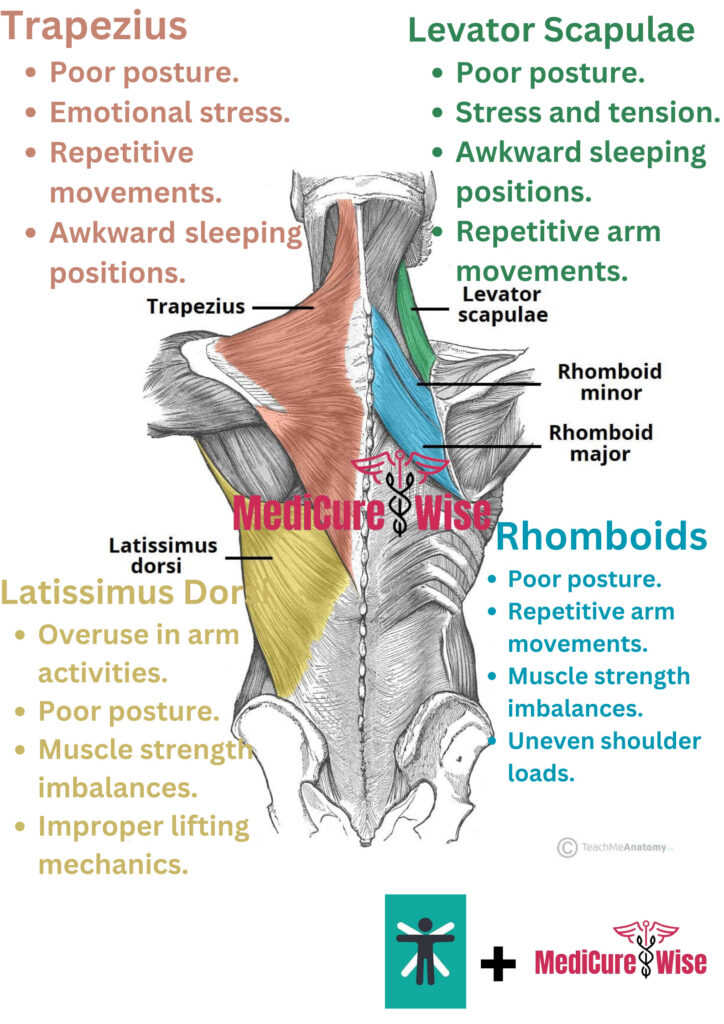Back Pain Chart
Back pain is a growing concern worldwide. Modern work demands, prolonged sitting, and shifting lifestyles are key contributors. Age and BMI further amplify its occurrence. However, understanding the specifics can be daunting. That’s where back pain charts come in.
These visual Back Pain Location Charts help pinpoint the causes and locations of pain, aiding in better diagnosis and treatment strategies. Delving deeper into these charts can offer invaluable insights for both patients and healthcare providers.
Back Pain Location Chart for Referred Pain
Referred pain is a phenomenon where pain is felt in a location different from the actual source of the pain. For instance, a problem in one part of the body might cause pain in another part.
When considering back pain, there are various areas where pain might be referred from. Here’s a simplified chart detailing some common sources of referred pain related to the back:

Back Pain Location Chart – Region of Spine

Back Pain Location Chart: Common Pain Points in Spine
Lower back pain is a common ailment, and one of its frequently misunderstood causes is degenerative disc disease. Dr. Sharma sheds light on this condition, emphasizing that it’s not a progressive or threatening disease, but rather a degenerative condition associated with the natural aging process.

Back Pain Location Chart – Muscles
Muscle trigger points are specific areas within muscles that can become tight and sensitive, often causing localized pain or referred pain. Here are some of the most common muscle trigger points associated with back pain:
Trapezius Muscle:
- Location: Upper back and neck.
- Trigger Points: Often found at the base of the neck and along the upper border of the shoulder blades.
- Common Causes: Poor posture, stress, and overuse of the shoulder and neck muscles.
Levator Scapulae Muscle:
- Location: Along the side and back of the neck.
- Trigger Points: Typically at the junction of the neck and shoulder.
- Common Causes: Poor posture, stress, and neck strain.
Rhomboid Muscles:
- Location: Between the shoulder blades.
- Trigger Points: Along the inner edge of the shoulder blades.
- Common Causes: Poor posture, repetitive motion, and muscle imbalances.
Latissimus Dorsi Muscle:
- Location: Large muscle spanning the mid to lower back.
- Trigger Points: Often near the lower edge of the shoulder blade and along the spine.
- Common Causes: Overuse, poor posture, and imbalances in muscle strength.

Erector Spinae Muscles:
- Location: Along the spine, on either side.
- Trigger Points: Commonly found at various points along the length of the spine.
- Common Causes: Poor posture, lifting heavy objects with improper form, and prolonged sitting.
Quadratus Lumborum Muscle:
- Location: Deep in the lower back, connecting the spine to the pelvis.
- Trigger Points: Typically found in the lower back near the spine and above the hip.
- Common Causes: Poor posture, repetitive movements, and sitting for extended periods.
Psoas Major Muscle:
- Location: Deep in the front of the hip and lower spine.
- Trigger Points: Can be felt along the front of the hip and lower back.
- Common Causes: Prolonged sitting, poor posture, and imbalances in hip muscles.
Scalene Muscles:
- Location: On the sides of the neck.
- Trigger Points: Often found near the base of the neck and along the side of the throat.
- Common Causes: Poor posture, neck strain, and respiratory issues.
Types of Back Pain
Acute vs. Chronic Back Pain:
Acute Back Pain:
- Definition: Acute back pain refers to pain that lasts for a short period, usually less than six weeks. It often occurs suddenly due to an injury or strain.
- Common Causes: Acute back pain can result from lifting heavy objects, sudden movements, sports injuries, or accidents.
Chronic Back Pain:
- Definition: Chronic back pain persists for longer durations, typically more than three months. It can stem from an initial acute injury or develop gradually over time.
- Common Causes: Chronic back pain may be caused by conditions like herniated discs, spinal stenosis, arthritis, or persistent poor posture.
Common Causes of Back Pain
Muscle Strains and Sprains:
Muscle strains and sprains are common culprits behind back pain, often resulting from improper lifting, sudden movements, or poor posture.
Causes:
- Improper Lifting: Lifting heavy objects with incorrect techniques can strain the back muscles.
- Sudden Movements: Abrupt twists or turns can lead to muscle sprains.
- Poor Posture: Prolonged periods of sitting or standing with poor posture can strain the back muscles.
Prevention Tips:
- Lift with your legs, not your back.
- Warm up before physical activity.
- Maintain good posture, especially when sitting for extended periods.
- Incorporate core-strengthening exercises into your routine.
Herniated Discs:
A herniated disc occurs when the soft inner core of a spinal disc protrudes through the tough outer layer, causing back pain.
Causes:
- Aging: Wear and tear on the discs over time.
- Injury: Trauma or sudden pressure on the spine.
- Genetics: Family history can influence disc health.
Risk Factors:
- Obesity.
- Prolonged sitting.
- Repetitive lifting or bending.
Treatment Options:
- Rest and activity modification.
- Physical therapy.
- Medications for pain and inflammation.
- In severe cases, surgery may be considered.
Spinal Stenosis:
Spinal stenosis is the narrowing of the spinal canal, leading to pressure on the spinal cord and nerves.
Impact on the Spinal Canal:
- Restricts the space available for the spinal cord and nerves.
- Results in pain, numbness, or weakness in the back and legs.
Symptoms:
- Pain or cramping in the legs.
- Numbness or tingling.
Treatment Options:
- Physical therapy to improve flexibility.
- Medications for pain management.
- In advanced cases, surgery may be recommended.
Osteoarthritis and Degenerative Disc Disease:
Osteoarthritis and degenerative disc disease contribute to back pain as joints and discs wear down over time.
Contribution to Back Pain:
- Osteoarthritis: Breakdown of cartilage in joints.
- Degenerative Disc Disease: Deterioration of spinal discs.
Lifestyle Changes and Interventions:
- Maintain a healthy weight.
- Regular exercise to strengthen muscles.
- Physical therapy for joint and muscle support.
- In some cases, surgery may be considered.
Prevention and Management
Exercise and Stretching:
- Core Strengthening: Engage in exercises like Bird Dog, Glute Bridge, and Squats to target and strengthen the core and lower back muscles.
- Regular Movement: Consistent physical activity can significantly alleviate back pain. Movement helps in strengthening muscles and reducing stiffness, making the back more resilient to pain episodes.
Ergonomics and Posture:
- Good Posture Tips: Ensure your chin, neck, and ears align over the shoulders. Keep your back straight, shoulders relaxed and down, and avoid locking your knees during activities.
- Workstation Ergonomics: Adjust your chair height so your feet rest flat on the ground. Position your computer monitor at eye level and ensure your arms are parallel to the ground when typing.
Weight Management:
- Weight and Back Pain: Excess weight, especially around the midsection, can strain the back and increase the risk of pain. Maintaining a healthy weight reduces this strain and potential discomfort.
- Guidance: Focus on a balanced diet rich in nutrients and engage in regular physical activity. Consulting with a nutritionist or a fitness expert can provide personalized strategies for weight management.
Seeking Professional Help
When to See a Doctor:
Red Flags: Symptoms like pain that occurs at night, disrupts sleep, or remains unrelenting even after rest and analgesia should raise concerns for potential underlying issues such as infection or tumor.
Persistent or Severe Pain: It’s crucial not to overlook or dismiss ongoing or intense back pain. Early intervention can prevent complications and promote faster recovery.
Treatment Options:
Medications: Depending on the severity and cause of the back pain, doctors may prescribe pain relievers, muscle relaxants, or anti-inflammatory medications.
Physical Therapy: A regimen of exercises and therapeutic techniques can help strengthen the back, improve flexibility, and alleviate pain.
Surgical Interventions: In severe cases or when conservative treatments fail, surgical options like discectomy or spinal fusion may be considered.
Personalized Treatment Plans: Recognizing that every patient is unique, it’s essential to have tailored treatment strategies that consider individual needs, lifestyle, and responsibilities.
Several renowned doctors and specialists in the US are recognized for their expertise in treating back pain:
- Ehsan Saadat, MD: Recognized as one of the best orthopedic spine surgeons in the United States.
- John Rhee, MD: Another top orthopedic spine surgeon in the US.
- John Heller, MD: Renowned for his expertise in spine surgery.
- Scott Boden, MD: A leading figure in orthopedic spine surgery.
- Christopher Bono, MD: Known for his contributions to spine surgery.
Additionally, clinics and centers such as Pain Treatment Specialists and The Advanced Spine Center provide comprehensive guides and listings to help individuals choose the right doctor for their back pain.

